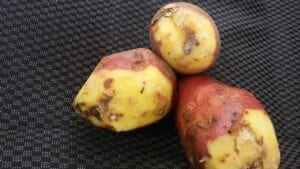TRV is one of two viruses causing spraing in potato that is most commonly associated with tuber internal blemishing (see also PMTV). These defects are significant and cause rejections of both ware and processing crops.Symptoms do not increase during storage.
Symptoms
TRV spraing symptoms are not usually visible on the tuber surface but in tuber flesh the infection causes brown flecking and arcs, which are occasionally concentric,. In severe cases these lesions appear corky.. Plants grown from infected seed can be healthy but in certain varieties infection may cause stunted stems with mottled and/or distorted leaves. Leaves may have yellow rings or brown arcs, pinched leaflet tips and edges, later associated with a reddish brown fringe. Plants showing these symptoms result in smaller and/or misshapen tubers with a lower overall yield. Small spots and arcs can reappear on the progeny.
Tuber internal flecking caused by spraing is often mistaken for internal rust spot.
Transmission
The vectors of TRV are free living nematodes and consequently the defect is often seen in light sandy or gravelly soils favourable to the vector. Infection is more likely if those soils are wet at tuber initiation.
Control
TRV has a wide broad leaved plant host range. Consequently long rotations involving cereals and effective weed control can reduce virus levels in a field, but not the number of nematode vectors. Excessive irrigation should be avoided at tuber initiation as infection is most likely at this stage. Some varieties are completely resistant and do not host the virus, others are tolerant and show few symptoms in its presence. Take particular care with susceptible varieties in which severe symptoms can be produced by infection at even low virus levels. Commercial testing of virus carried by nematodes in the field is available.




